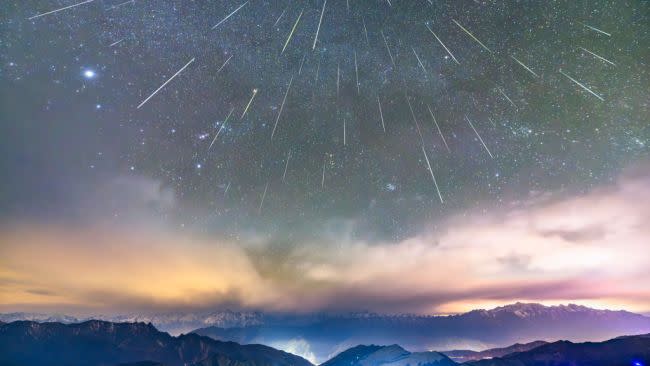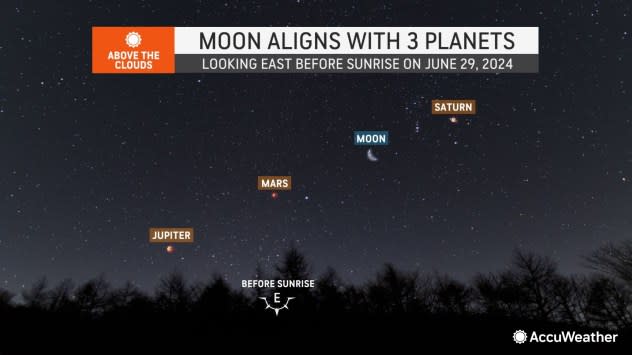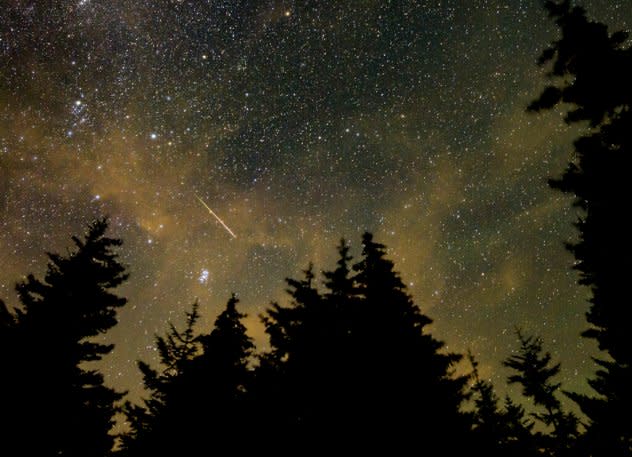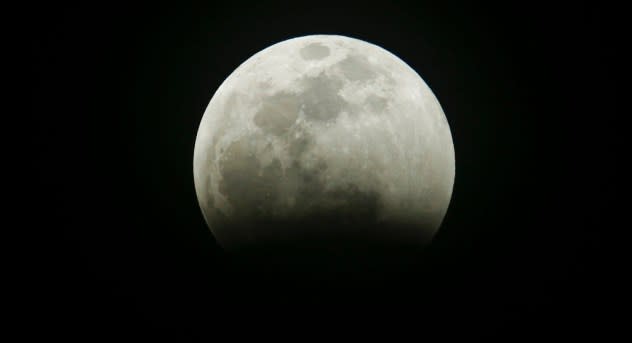Eclipses, meteor showers and alignments: The astronomy events you won't want to miss in 2024
The new year brings a fresh slate of exciting astronomical events in the night sky, and one that will take place in the middle of the day that, for many, will be a once-in-a-lifetime spectacle.
From planetary alignments to a "Super Harvest Moon Eclipse," here are the top astronomy events to mark on your 2024 calendar:
Less than a week after the spring equinox, which takes place on March 19 at 11:06 p.m. EDT, stargazers will be able to see the year's first eclipse.
A penumbral lunar eclipse will unfold before daybreak on Monday, March 25, and will be visible across North America South America, western Europe, western Africa, Japan, New Zealand and part of Australia.
 |
The moon passes into the earth's shadow during a lunar eclipse as seen in Gauhati, India, Wednesday, Jan. 31, 2018. (AP Photo/Anupam Nath) |
This type of eclipse can be underwhelming and difficult to notice as the moon only passes through Earth's outer shadow, known as the penumbra, which is not nearly as dark as its inner shadow, the umbra. However, it will be the precursor to a jaw-dropping spectacle that will unfold just two weeks later.
Millions of people will travel from around the world to see the top astronomy event of 2024, and for North America, it will arguably be the best astronomy event of the decade.
For a few moments on Monday, April 8, the moon will completely block out the sun to create a stunning total solar eclipse, the first for North America since 2017. It will only be visible along a narrow path from Texas to Maine and portions of Mexico and Atlantic Canada.
 |
People across the rest of North America will be able to see an impressive partial solar eclipse, although solar filters or eclipse glasses will be needed to safely look at the event. Experts recommend purchasing eclipse glasses months ahead of time as vendors could sell out as the event draws near.
 |
In this Aug. 21, 2017 file photo, the moon almost eclipses the sun during a near total solar eclipse as seen from Salem, Ore. (AP Photo/Don Ryan, file) |
After April, a total solar eclipse will not be visible from the contiguous United States until 2044.
Following a nearly four-month spell with no meteor showers, skywatchers will have the opportunity to watch two in as many weeks.
The Lyrids will light up the night sky first, peaking on the night of Tuesday, April 22, into the early morning of Wednesday, April 23. Typically, the shower produces around 15 shooting stars per hour, but this year, a nearly full moon will outshine all but the brightest meteors.
GET THE FREE ACCUWEATHER APP
•Have the app? Unlock AccuWeather Alerts™ with Premium+
Two weeks later on the night of Sunday, May 5 into the early morning of Monday, May 6, the Eta Aquarid meteor shower will peak. This is the best meteor shower of the year for the Southern Hemisphere when rates will reach 50 meteors per hour, while folks in the Northern Hemisphere could count 10 to 30 shooting stars per hour.
An eye-catching astronomical alignment will take center stage in the early summer sky, although it will require waking up before the crack of dawn to witness it.
The moon will fall in line with Jupiter, Mars and Saturn before daybreak on Saturday, June 29 in the eastern sky.
 |
No telescope is required to see the alignment, but having one will reveal two more planets, both of which are too dim to see with the naked eye. Uranus will glow faintly between Jupiter and Mars, while Neptune will appear between Saturn and the moon.
A dazzling display will unfold in the heavens near the middle of August as the best meteor shower of 2024 reaches its peak.
More than 50 meteors per hour will streak through the sky when the Perseids peak on the night of Monday, Aug. 12 into the early hours of Tuesday, Aug. 13, according to the American Meteor Society. The number of visible meteors could peak near 100 per hour from dark areas devoid of light pollution.
 |
In this 30 second cameras exposure, a meteor streaks across the sky during the annual Perseid meteor shower, Wednesday, Aug. 11, 2021, in Spruce Knob, West Virginia. (Bill Ingalls/NASA via AP) |
The best viewing conditions are expected during the second half of the night after the moon has set, and when the shower's radiant point, located near the constellation Perseus, rises high in the northeastern sky.
One week after the peak of the Perseids, an uncommon lunar event will take place with the rise of a Blue Moon.
A Blue Moon is often the nickname given to the second full moon in a calendar month, but this year's Blue Moon goes by a different definition. Most astronomical seasons feature three full moons, but when four fall in a season, like what will happen this summer, the third of the quartet is called a Blue Moon
Despite what the nickname suggests, the moon will not appear blue in the sky. August's full moon is also known as the Sturgeon Moon, the Black Cherries Moon and the Mountain Shadows Moon.
As the muggy summer nights begin to give way to crisper autumn evenings, one of the largest planets in the solar system will be the main attraction in the sky.
Saturn will reach opposition on Sunday, Sept. 8, the point in its orbit when it appears in the exact opposite part of the sky as the sun, and around the same time it is closest to the Earth. As a result, the planet will appear brighter than at any other time of the year.
No telescope is needed to spot Saturn, but having one may reveal its famous rings, which are the inspiration behind the planet's nickname: The jewel of the solar system.
A confluence of three popular lunar events will make for an exciting night of stargazing on the night of Tuesday, Sept. 17, into the early hours of Wednesday, Sept. 18.
A partial lunar eclipse will coincide with the first supermoon of the year, causing part of the moon to temporarily go dark as it passes through Earth's shadow. This event will be more impressive than the penumbral lunar eclipse in March, although it will be a far cry from a blood-red total lunar eclipse.
 |
A lunar eclipse progresses is seen in Los Angeles, Sunday Jan. 20, 2019. (AP Photo/Ringo H.W. Chiu) |
September's full moon will also be the famous Harvest Moon, leading to the long-winded nickname of the "Super Harvest Moon Eclipse."
Three months after the Saturn opposition, it will be Jupiter's time to shine in the sky as the largest planet in the solar system reaches peak brightness.
Jupiter will be visible all night long throughout December, but the first weekend of the month will be the best time to view the planet as it reaches opposition.
Similar to the Saturn opposition, no telescope is needed to see Jupiter as it will outshine every star in the sky, but spying on the planet with a telescope will reveal its largest moons, colorful clouds and even its famous red spot -- a storm that has been raging on the planet for centuries.
December features the longest nights of the year, and around the middle of the month, stargazers usually bundle up to enjoy the Geminids -- one of the best annual meteor showers. However, 2024's edition of the wintertime meteor shower will likely fizzle instead of sizzle.
The night of Friday, Dec. 13 into the morning of Saturday, Dec. 14, will bring the peak of the Geminid meteor shower. Under ideal conditions, onlookers can count over 100 shooting stars per hour, but this year, it will peak on the same night as a nearly full moon. The bright moonlight will make it difficult to see many of the meteors associated with the Geminids.
 |
The Geminid meteor shower is being seen at the top of Niubei Mountain in Ya'an, Sichuan Province, China, on December 14, 2023. (Photo by Costfoto/NurPhoto via Getty Images) |
Some shooting stars may still be seen in darker areas of the sky where the moon is out of view. A much better light show is expected in 2025 as moonlight will not hinder the Geminids.
Want next-level safety, ad-free? Unlock advanced, hyperlocal severe weather alerts when you subscribe to Premium+ on the AccuWeather app. AccuWeather Alerts™ are prompted by our expert meteorologists who monitor and analyze dangerous weather risks 24/7 to keep you and your family safer.








